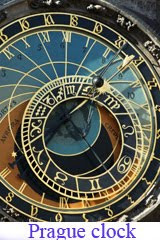Known locally as Orloj, its beautiful and intricate clock face is the work of various masters of the art of clock making. It was originally created by Mikuláš, the King’s watchmaker from the Czech city of Kadan, but it was later modernised by in the 16th century by Jan Taborský.
During the Prague Uprising of 1945 the Orloj was heavily damaged by Nazi bombs. Over the next few years a community effort was made it get it working again and it hasn’t stopped since, as legend has it that if it did Prague itself would stop functioning.

The Orloj is a sum of various parts and the astronomical dial is perhaps the most mystical. Most experts consider it to be a primitive form of a planetarium as with its rotating ring of zodiacal signs it displays the current position of the planets. Even more interesting is the background of the Orloj, which is coloured in semicircular shapes of blue, red and black (representing day, night and dusk). On the outer edge, two sets of golden numerals mark the 24-hour timescale as well as antiquated Czech time when the midnight (as we understand it today) took place at sunset.
But the most crowd-pleasing element of the Orloj is the four, strange and macabre figures underneath the clock face. They represent anxieties that the community had in the 15t century; death (represented by a skeleton), paganism (a Turk), vanity and greed (two figures with mirror and money bag respectively). When Orloj strikes the hour, ‘death’ inverts his hourglass, and statuettes of the 12 apostles parade past in a window above.